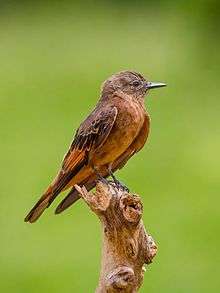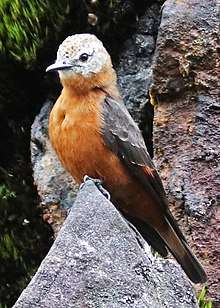Cliff flycatcher
The cliff flycatcher (Hirundinea ferruginea) is a species of bird in the tyrant flycatcher family, Tyrannidae. The cliff flycatcher is the only species in the genus Hirundinea after the swallow flycatcher was merged, becoming subspecies Hirundinea ferruginea bellicosa. It is native to South America, where its natural habitats are cliffs and crags in the vicinity of subtropical or tropical dry forest, subtropical or tropical moist lowland forest, subtropical or tropical moist montane forest, and heavily degraded former forest.
| Cliff flycatcher | |
|---|---|
 | |
| In Pindamonhangaba, São Paulo, Brazil | |
| Scientific classification | |
| Kingdom: | Animalia |
| Phylum: | Chordata |
| Class: | Aves |
| Order: | Passeriformes |
| Family: | Tyrannidae |
| Genus: | Hirundinea Orbigny & Lafresnaye, 1837 |
| Species: | H. ferruginea |
| Binomial name | |
| Hirundinea ferruginea (Gmelin, 1788) | |
| Synonyms | |
|
Hirundinea bellicosa (Vieillot, 1819) | |
Description

The adult cliff flycatcher is about 18.5 cm (7.3 in) long. It has a wide beak and long pointed wings, resembling those of a swallow. The upper parts are dusky brown, with a distinctive rufous rump and base of tail. The tips of the wing feathers are dark, but the remaining parts are cinnamon-rufous and these are exposed in flight. The underparts are pale cinnamon-rufous, with some grey speckling on the throat.[2]
Distribution and habitat
The cliff flycatcher is only found east of the Andes cordillera, and therefore is not found in Chile. All other countries in South America are represented in its range. In the Amazon basin, it surrounds the basin in the foothills, and highest elevations at tributaries' headwaters; it ranges down to central Argentina west of the Pampas, and east of the Pampas to southern Brazil, Paraguay and Uruguay; also southeast of the Amazon Basin in the Brazilian Highlands, to the Atlantic and south Atlantic coast of Brazil, about an 8,000 km (5,000 mi) stretch of coastline.[1] Its natural habitat is in the vicinity of cliffs and gorges, canyons, rocky outcrops, quarries and road cuttings. It is also found, particularly in the south of its range, around buildings in cities, where the windowsills and facades provide a form of artificial cliff. Southerly populations are migratory while more northerly ones are sedentary.[2]
Ecology
The cliff flycatcher perches in a prominent position, sallying to hawk for insects in spectacular aerial flying displays. It nests on cliff ledges, stabilising the nest by arranging pebbles in a ring to support the structure. In the city environment of São Paulo, it breeds on the windowsills of high rise blocks.[3]
References
- BirdLife International (2016). "Hirundinea ferruginea". IUCN Red List of Threatened Species. Version 2019.3. International Union for Conservation of Nature. Retrieved 5 February 2020.CS1 maint: uses authors parameter (link)
- Ridgely, Robert S.; Tudor, Guy; Brown, William L. (1989). The Birds of South America: Vol. II, The Suboscine Passerines. University of Texas Press. p. 593. ISBN 978-0-292-77063-8.
- DK; BirdLife International (2011). The Illustrated Encyclopedia of Birds. Dorling Kindersley Limited. p. 343. ISBN 978-1-4053-3616-1.
External links

- Cliff flycatcher videos on the Internet Bird Collection
- Photo-Medium Res; Article John Kormendy: Birds of Brazil - University of Texas Astronomy
- Cliff flycatcher photo gallery VIREO (Visual Resources for Ornithology)
